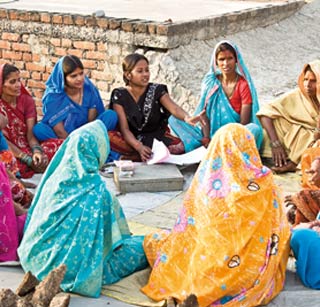 Building Skills and Social Infrastructure around our Factories Building Skills and Social Infrastructure around our Factories
For the households around our Units, the challenge is that of providing the necessary social infrastructure to enable a decent quality of life. Thus these projects aim to create sustainable livelihoods through community development for our second group of stakeholders - Communities in Factory Catchments.
| Women Empowerment and Skill Building |
These projects aim to empower and create sustainable income opportunities for women by mobilising them into self-help groups, promoting thrift and linking them to financial institutions for access to credit.
A total of 1,314 SHGs were functional during the period with a membership of 15,068 women handling a total micro-credit corpus of ` 206 lakhs. In addition, the groups raised ` 69 lakhs as loans from banks for various income generation activities. Creating employment opportunities for youth through vocational training and skill building activities ensures an additional source of income to the families and as a result leads to development of the community.
| Activity |
Cum to
2009-10 |
Performance
2010-11 |
Cum to
date |
| Micro Credit Programme |
| SHGs |
1,035 |
1,314 |
1,314* |
| Members |
14,278 |
15,068 |
15,068* |
| Savings (` L) |
179 |
205.59 |
206* |
| Livelihoods |
| Self
Employed |
23,797 |
5,993 |
29,790 |
| Micro
enterprises |
5,898 |
1,848 |
7,746 |
| Credit |
| Internal
loans (` L) |
306.79 |
89.95 |
396.74 |
| External
loans (` L) |
398.14 |
69.90 |
468.04 |
| * The figures are as on date |
|
|
 |
| Primary Education and Health and Sanitation |
| Activity |
Cum to
2009-10 |
Performance 2010-11 |
Cum to
date |
| Primary Education |
| Learning Centres
(No) |
2,380 |
143 |
2,523 |
| Rural Libraries
(No of schools) |
304 |
53 |
357 |
| Roaming Laptop
(No of schools) |
260 |
55 |
315 |
| Govt Schools Infra
support
(No of school |
577 |
164 |
741 |
| Text/Exercise
books (No) |
2,28,415 |
1,25,450 |
3,53,865 |
| Children
covered |
2,28,872 |
18,193 |
2,47,065 |
| Health & Sanitation |
| Sanitary toilets
(No) |
2,937 |
283 |
3,220 |
| Backyard
horticulture
(No saplings) |
23,614 |
- |
23,614 |
| Health camps
(No) |
309 |
5 |
314 |
| Beneficiaries (No) |
21,780 |
1,039 |
22,819 |
A strong foundation in primary education and skill building for the children in the community is a step towards ensuring sustainable development for the community as a whole. The initiative with its focus on minimising dropouts and ensuring every child is in school and learning well aims at enriching the process of learning. It also enhances the learning environment by giving infrastructural support to the Government Schools.
Over 18,000 children were covered under the education programme, through the 251 supplementary learning and coaching centres, the roaming laptop and library initiatives. Thus the total number of children covered till date is almost 2.48 lakhs.
Improvement in the status of health and sanitation conditions in a community is an indication of the overall development of the community. Thus the initiatives in health and sanitation aim at creating an environment which addresses the health and sanitation needs of the community. There were 283 low cost toilets that were built this year. The total number of health camps till date are 314 reaching out to over 22,000 patients.

|

